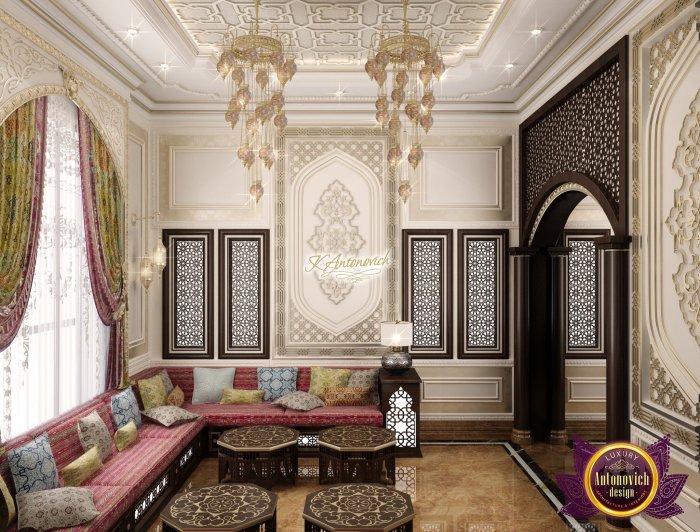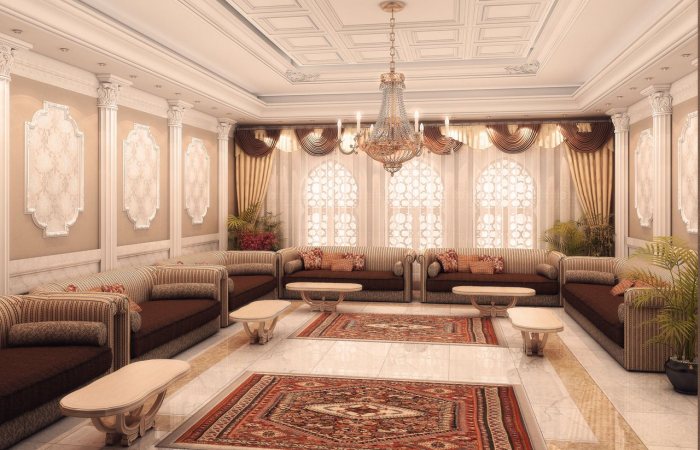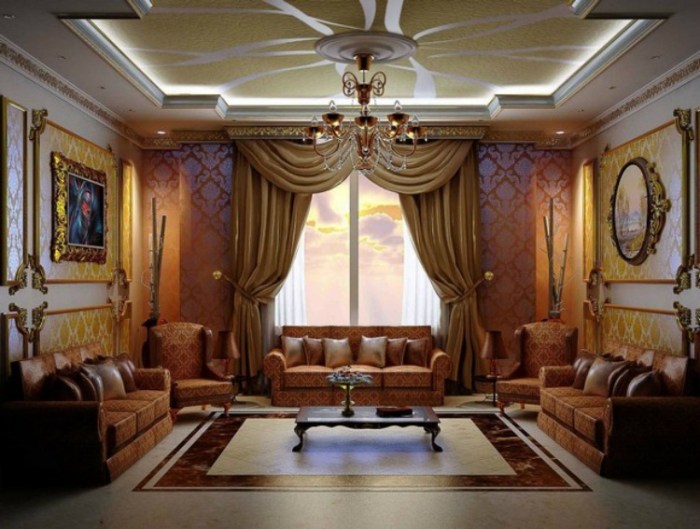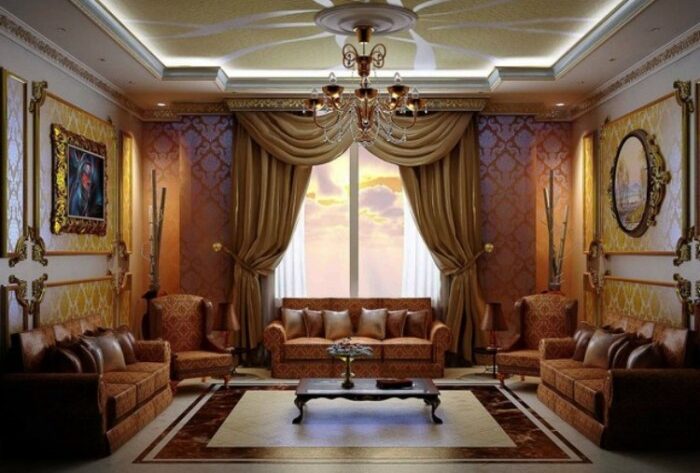Arabian style house interior design transports you to a world of opulent elegance and intricate detail. Inspired by centuries of rich history and cultural heritage, this style embraces warmth, comfort, and a captivating sense of artistry. From the vibrant color palettes and intricate patterns to the use of luxurious materials and traditional furniture, Arabian interiors offer a unique and unforgettable experience.
This guide delves into the key elements of Arabian style, exploring its origins, design principles, and practical applications. Whether you’re seeking to infuse your home with a touch of Arabian charm or embark on a complete transformation, this exploration will provide valuable insights and inspiration.
Introduction to Arabian Style

Arabian style, deeply rooted in the rich cultural heritage of the Middle East, has evolved over centuries, showcasing a unique blend of tradition, craftsmanship, and artistic expression. It has transcended geographical boundaries, influencing interior design globally, and continues to inspire contemporary designers with its captivating aesthetics.
Origins and Historical Influences
Arabian style, in its essence, reflects the cultural and historical influences of the Arabian Peninsula, particularly those of the Islamic Golden Age (8th to 13th centuries). During this period, the region witnessed significant advancements in art, architecture, and science, leading to the development of distinctive design principles that were widely adopted across the Islamic world.
The influence of ancient civilizations, such as the Romans, Greeks, and Persians, is evident in Arabian architecture and design, shaping its distinct characteristics.
Key Characteristics and Elements of Arabian Style
Arabian style is renowned for its intricate details, opulent materials, and harmonious use of color and pattern.
Key Characteristics and Elements of Arabian Style
- Intricate Patterns and Motifs:Geometric patterns, floral motifs, and calligraphy are prominent elements of Arabian design, often used to adorn walls, ceilings, furniture, and textiles. These intricate patterns are inspired by Islamic art and architecture, symbolizing the beauty and complexity of the universe.
- Rich Colors and Textures:Arabian style embraces a vibrant palette of colors, with rich hues like gold, crimson, turquoise, and emerald green being frequently employed. These colors, often used in combination with warm earthy tones, create a sense of opulence and warmth. The use of luxurious materials such as silk, velvet, and marble adds to the overall richness and texture of the interior.
- Arches and Domes:Arches and domes are prominent architectural features of Arabian design, creating a sense of grandeur and elegance. These structures, often adorned with intricate carvings and mosaics, are a testament to the architectural mastery of the region.
- Courtyards and Gardens:Arabian architecture places a strong emphasis on creating indoor-outdoor spaces. Courtyards and gardens, often featuring lush greenery, fountains, and decorative elements, are integral to Arabian homes, providing a sense of tranquility and connection to nature.
- Use of Light and Space:Arabian design often utilizes light and space to create a sense of openness and grandeur. Large windows, intricate latticework, and strategically placed mirrors reflect light, creating a luminous and inviting atmosphere.
Color Palette and Patterns
The color palette and patterns used in Arabian interiors are a significant aspect of the style, contributing to the overall richness, warmth, and cultural significance of the design. These elements reflect the region’s history, traditions, and artistic heritage.
Warm Tones and Earth Colors
Warm tones and earth colors dominate the Arabian color palette, creating a sense of comfort, hospitality, and connection to the natural world.
- Red: A symbol of passion, energy, and strength, often used in accents and decorative elements.
- Orange: Represents warmth, joy, and prosperity, often used in textiles and furnishings.
- Yellow: Associated with sunshine, happiness, and optimism, often used in walls and ceilings.
- Green: Symbolizes life, growth, and abundance, frequently used in gardens and outdoor spaces.
- Blue: Evokes peace, tranquility, and the vastness of the desert sky, often used in accents and decorative elements.
- Brown: Represents the earth, stability, and groundedness, often used in wood furniture and flooring.
Metallic Accents, Arabian style house interior design
Metallic accents, particularly gold and silver, add a touch of opulence and grandeur to Arabian interiors.
- Gold: Represents wealth, power, and royalty, often used in decorative elements, furniture, and lighting.
- Silver: Symbolizes purity, elegance, and sophistication, often used in accents, tableware, and decorative objects.
Geometric Patterns
Geometric patterns are prevalent in Arabian design, often inspired by Islamic art and architecture. These patterns are characterized by their intricate details, symmetry, and repetition.
Arabian style house interior design often evokes a sense of grandeur and opulence, with intricate details and rich textures. While a spacious villa might be the ideal canvas for such a design, it can also be adapted for smaller spaces, such as apartments.
If you’re looking for inspiration on how to bring this style to your own home, check out resources on apartment house interior design , which often feature clever design tricks for maximizing space. Regardless of your home’s size, incorporating elements like geometric patterns, warm color palettes, and luxurious fabrics can create a truly captivating Arabian-inspired atmosphere.
- Arabesque: A complex and intricate pattern featuring interwoven lines, curves, and shapes, often found in mosaics, tiles, and textiles.
- Geometric Motifs: Squares, circles, triangles, and other geometric shapes are frequently used in patterns, creating a sense of order and balance.
- Latticework: A pattern of intersecting lines, creating a grid-like effect, often found in windows, screens, and ceilings.
Floral Motifs
Floral motifs are another common element in Arabian design, often symbolizing beauty, life, and paradise. These motifs are often incorporated into textiles, ceramics, and decorative elements.
- Roses: A symbol of love, beauty, and passion, often used in carpets, cushions, and wall hangings.
- Lilies: Represent purity, innocence, and grace, often used in textiles and decorative objects.
- Jasmine: A fragrant flower associated with love, romance, and beauty, often used in perfumes and decorative elements.
Calligraphy
Calligraphy, the art of beautiful writing, is an integral part of Arabian culture and design. Arabic script is often used in decorative elements, wall art, and furniture.
- Verses from the Quran: Calligraphy is often used to inscribe verses from the Quran, adding a spiritual and cultural dimension to the design.
- Poetry and Proverbs: Arabic calligraphy is also used to inscribe poetry, proverbs, and other literary works, adding a touch of elegance and sophistication.
Furniture and Decor: Arabian Style House Interior Design
Arabian interior design is not only about the visual appeal of the space but also about the comfort and functionality of the furniture. Traditional Arabian furniture is known for its intricate craftsmanship, luxurious materials, and rich history. It is an essential part of the overall aesthetic, reflecting the culture and traditions of the region.
Traditional Arabian Furniture
Traditional Arabian furniture is characterized by its low seating, ornate chests, and intricately carved wooden pieces.
- Low Seating:Arabian homes often feature low seating arrangements, such as floor cushions, ottomans, and diwans. These pieces are typically made of luxurious materials like velvet, silk, or leather and are often adorned with intricate embroidery or beadwork. These low seating arrangements encourage a sense of community and hospitality, making guests feel comfortable and welcome.
Arabian style house interior design is known for its opulent and intricate details, often featuring rich fabrics, elaborate patterns, and a sense of grandeur. When planning such a design, utilizing 3d design house interior software can be incredibly helpful.
It allows you to visualize the space, experiment with different textures and colors, and ensure the final result aligns with your vision. The software’s ability to create realistic renderings makes it easy to see how the final design will translate into a physical space, further enhancing the luxurious ambiance of an Arabian-inspired home.
- Ornate Chests:Ornate chests, known as “sanduq,” are another staple of traditional Arabian furniture. These chests are often made of wood and are intricately carved with geometric patterns, floral motifs, or calligraphy. They are used to store valuables, clothing, and other personal items.
Sanduq are often passed down through generations, becoming cherished family heirlooms.
- Intricately Carved Wooden Pieces:Arabian artisans are renowned for their skill in woodcarving. Intricately carved wooden pieces, such as doors, windows, and furniture, are a common sight in traditional Arabian homes. These pieces often feature intricate geometric patterns, floral motifs, and calligraphy, reflecting the rich cultural heritage of the region.
These intricate carvings are not only decorative but also functional, adding strength and durability to the furniture.
Decorative Elements
Decorative elements like cushions, throws, and textiles play a crucial role in creating a luxurious and inviting atmosphere in Arabian interiors.
- Cushions:Cushions are an essential part of Arabian seating arrangements. They are often made of luxurious fabrics like velvet, silk, or brocade and are adorned with intricate embroidery or beadwork. Cushions come in various shapes and sizes, adding a touch of comfort and elegance to the space.
- Throws:Throws are used to add warmth and texture to the space. They are often made of luxurious fabrics like cashmere, wool, or silk and are often adorned with intricate embroidery or beadwork. Throws can be used to cover furniture, add a splash of color to the room, or provide warmth on chilly evenings.
- Textiles:Textiles play a vital role in Arabian interior design. They are used to create a sense of warmth, comfort, and luxury. Traditional Arabian textiles, such as carpets, rugs, and tapestries, are often hand-woven and feature intricate patterns, geometric designs, and rich colors.
These textiles add a touch of history and culture to the space, reflecting the rich heritage of the region.
Lighting and Ambiance

Lighting plays a vital role in creating the warm and inviting atmosphere that defines Arabian interiors. It’s not just about illumination; it’s about evoking a sense of luxury, comfort, and mystery. Arabian homes are designed to be sanctuaries, and lighting is a key element in achieving this.
Chandeliers and Lanterns
Chandeliers are a signature element of Arabian interiors, adding a touch of grandeur and elegance. They come in various styles, from ornate crystal chandeliers to more minimalist designs. Lanterns, on the other hand, provide a softer, more intimate light. They are often made of metal, glass, or wood and are decorated with intricate patterns.
Both chandeliers and lanterns contribute to the overall ambiance, creating a warm and inviting atmosphere.
- Chandeliers:The shimmering light from a crystal chandelier adds a touch of sparkle and opulence to a room. They can be used in the living room, dining room, or even the bedroom, creating a focal point that draws attention.
- Lanterns:Lanterns provide a more diffused and romantic light, ideal for creating a cozy and inviting atmosphere. They can be placed on tables, shelves, or hung from the ceiling. Lanterns often feature intricate designs and are made from materials like brass, copper, or glass, adding a touch of traditional charm to the interior.
Candles
Candles are another essential element in Arabian interiors. They create a soft, flickering light that adds a touch of romance and warmth to the atmosphere. Candles are often used in combination with other light sources, such as chandeliers and lanterns, to create a layered lighting effect.
They can be placed in decorative holders, on tables, or even on the floor, adding a touch of sophistication to the décor.
- Scented Candles:Scented candles add a delightful fragrance to the room, enhancing the overall ambiance. Popular scents in Arabian interiors include oud, rose, and amber.
- Candle Holders:Candle holders are often crafted from materials like brass, silver, or ceramic and are decorated with intricate designs. They serve as decorative elements while holding the candles.
Last Point

By incorporating the elements of Arabian style, you can create a home that is both beautiful and culturally rich. Whether you choose to embrace the traditional elements or opt for a more modern interpretation, the essence of Arabian design offers a timeless aesthetic that transcends trends and inspires a sense of wonder.
FAQ Insights
What are some common materials used in Arabian interior design?
Arabian interiors often feature materials like marble, wood, intricate carvings, and luxurious textiles. Marble is frequently used for flooring, countertops, and decorative accents, while wood is incorporated into furniture, ceilings, and architectural elements. Intricate carvings adorn furniture, walls, and ceilings, adding a touch of artistry and craftsmanship.
Rich fabrics like silk, velvet, and brocade are used for upholstery, curtains, and decorative throws.
How can I incorporate Arabian style into a modern home?
While traditional Arabian style features ornate details and elaborate designs, modern interpretations often incorporate a more minimalist approach. You can achieve a modern Arabian aesthetic by using a neutral color palette, incorporating geometric patterns, and incorporating traditional elements like lanterns and cushions in a contemporary way.
Consider using modern furniture with clean lines and incorporating pops of color through textiles and decorative accents.
What are some key design elements to consider when creating an Arabian-inspired room?
When designing an Arabian-inspired room, focus on elements like color, patterns, furniture, and lighting. Choose a warm color palette with rich tones and incorporate intricate patterns like geometric motifs and floral designs. Opt for traditional Arabian furniture with low seating and intricate carvings, and use decorative elements like cushions, throws, and textiles with rich embroidery and textures.
Create a warm and inviting ambiance with chandeliers, lanterns, and candles.




